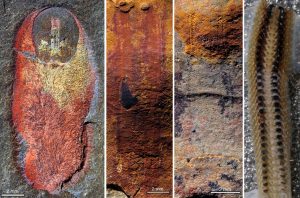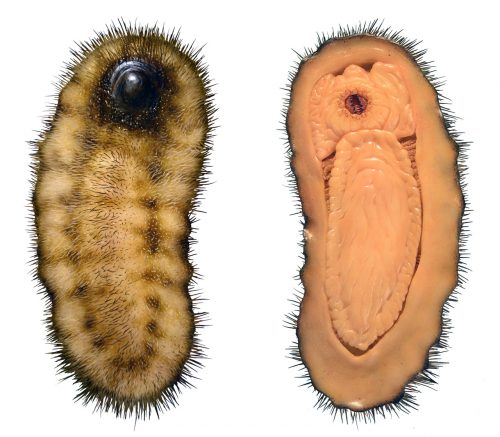Smooth, slimy, and anything but spiny are qualities that come to mind when one thinks of slugs. Slugs are part of the phylum Mollusca, a large group of invertebrate organisms with soft, unsegmented bodies. Originating 520 million years ago in the Cambrian Explosion—a period in Earth’s history when a great diversity of plants and animals developed—mollusks include a wide variety of species beyond the familiar garden snails and slugs. Types of mollusks include those with shell plates, like clams, or with radula, a tongue-like structure found in squids. The incredible diversity of mollusks arose during a surprisingly short time period of 20 million years after the Cambrian Explosion. The two main stem groups of mollusks that have developed since then are Aculifera, scale-bearing mollusks, and Conchifera, shell-bearing mollusks. Scientists have long pondered what a common ancestor of those groups would have resembled.
A recent discovery of the fossil Calvapilosa kroegeri, led by paleontologist and former Yale doctoral student Jakob Vinther and funded by a grant from the National Science Foundation and the Yale Peabody Museum of Natural

History, has helped researchers model the earliest common ancestor of mollusks. This organism is 480 million years old and was found in the Ordovician Fezouata Formation, a fossil-rich deposit in Morocco. It measures roughly four inches long. It most likely ate algae off of rocks, implied by how its jaw is lined with over 125 rows of tiny teeth. Complete fossils of the adult and juvenile were found, and the mollusk was reconstructed in enough detail to show what it looked like: a “hairy scalp” with a slightly balding spot in the middle. Thus the organism was given its name, Calvapilosa, or “hairy scalp.” It has spines extending over its entire upper body and a helmet shell on its head. In particular, the spines of Calvapilosa are more mineralized and consequently harder than those of earlier mollusks. However, its radula and shell potential satisfy the general criteria to be classified as a mollusk.
Calvapilosa is similar to two other older fossils of mollusks: Orthrozanclus, found in Canada, and Halkieria, found in Greenland. “However, Orthrozanclus and Halkieria are controversial in determining mollusk evolution, due their lack of certain unequivocal mollusc characteristics,” says Vinther. However, Calvapilosa’s definitively mollusk characteristics allowed Vinther to place Orthrozanclus and Halkieria more firmly onto the tree of life due to their similarities to Calvapilosa. Meanwhile, to clarify how Calvapilosa evolved its unique characteristics, scientists used phylogenetic analyses and mathematical models to estimate which tree of life the mollusk evolved from. They found two main branches of mollusk characteristics: one defined by shell plates and scales, and one with no scales but a single shell plate. Calvapilosa is the only known mollusk that has characteristics of both main branches.

With this new discovery, stronger hypotheses can be made about how mollusks diversified so quickly following the Cambrian Explosion. Ancestral mollusks were previously thought to be soft and shell-less. However, data from Calvapilosa suggests otherwise. In order to account for the newly found species, scientists hypothesize that the last common ancestor of the two main stem groups of mollusks, Aculifera and Conchifera, had a more flexible body plan. Rather than having the previously inferred characteristics, the common ancestor had radula with rows of differentiated teeth, non-biomineralized bristles, and a single calcareous shell. This body plan allowed for great morphological diversity to evolve later in mollusks, and fits with the already discovered species.
The discovery of Calvapilosa revolutionizes current knowledge on the common ancestor of mollusks, but does not end the story of mollusk evolution. “We must be constantly open to new discoveries that may support or refute our current hypotheses,” says Vinther. “In the meantime, we should look for as many fossils as possible to continue our search on mollusk evolution.” With Calvapilosa, scientists were able to come up with the best explanation based on current fossil data. It will be exciting to see how future fossil discoveries tie other pieces of evidence together, building and changing this evolutionary tale.

